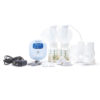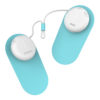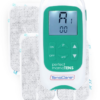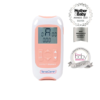What Everyone Should Know About Pelvic Health (updated for 2023)

What Everyone Should Know About Pelvic Health (updated for 2023)
We don’t talk about our pelvic health, yet so many people tell us about how they may run to the bathroom sometimes, or they may sneeze and leak. This is a huge deal, especially as you start to age. The problem is, we’ve all just been told to accept that this is a normal part of aging. We use our incontinence pads because we don’t want embarrassing leaks. Rather than think about how we can fix this problem, to make our pelvic floor stronger, or maybe find a solution, we just carry on with our day.
Watch our interview with The Vagina Coach, Kim Vopni or keep reading below.
Incontinence is NOT a normal part of aging.
We’re often told from even our care providers that incontinence and leaks are “because you’re approaching menopause, because you’ve had children, because you’re getting older…”
We hear this same message from the media that incontinence is just part of being a woman. There is nothing communicated to people that this is a treatable, fixable problem. You do not need to accept pads as your destiny. Incontinence is not a normal part of aging. It can be treatable.
You shouldn’t need to modify your lifestyle just to cope with symptoms.
You don’t need to change your lifestyle to incorporate the symptoms of incontinence. You can fix them so that you’re not thinking about your next bathroom break, and you’re not limiting your water intake, which are things that many of us do, or have done in the past, because that’s just sort of what you do to manage your symptoms.
Treat your pelvic health like oral health – get regular checkups.
We should be treating our pelvic health like our oral health. If you can, go see a pelvic floor physical therapist, at least once a year. Go, even if you have no symptoms, go for your checkup, because it helps screen for things like incontinence and organ prolapse which is when our organs start to shift out of their position. Especially as we’re aging and getting into perimenopause and menopause, this becomes even more common.
If possible, see a pelvic health specialist at least once a year. If not, find a resource that works for you to support your pelvic floor.
If for geographic, financial or comfort reasons you are not able to visit a pelvic health specialist, there are many other resources that can help. Our friend Kim Vopni, The Vagina Coach, uses fitness and lifestyle coaching to help women identify contributors to pelvic floor challenges and make positive changes to their diet, lifestyle and movement patterns that help. There are also some great products available which can help.
In an ideal world, if you can invest in seeing a pelvic floor specialist first, and then they can help you decide if a product, or a device, would be helpful for you.
If using a device to help with pelvic floor exercise, biofeedback is helpful.
If you’re going to start somewhere, a product can be a valuable resource, especially if there’s some biofeedback, meaning something that visually allows you to see what your muscles are doing. Because our pelvic floor is inside our bodies, we can’t stand in front of a mirror like we do when we’re working out in a gym to see what our muscles are doing.
The visualization is important to understanding how to do a Kegel properly. We’re all taught that Kegels are important, but how many of us know how to do a Kegel properly, and effectively?
Pelvic Floor devices can play a role in helping people identify the correct group of muscles while also providing visual feedback to be able to see if they are doing it correctly.
At Mother’s Choice Products, we love the Perfect PFE from TensCare exactly because it is effective at providing biofeedback that helps you see that your body is doing Kegels correctly.
The Perfect PFE has a probe that goes into the vagina, and an antenna for biofeedback. When you put the probe in your vagina and you have a proper contraction, the antenna will point upwards to let you know you’ve done the Kegel exercise correctly.
Both the contraction and the relaxation are key in pelvic floor exercises.
Doing your Kegels properly is important. Many people are okay with doing the contraction, but they don’t fully relax their pelvic floor enough. As an example, when you do a bicep curl, you can see your muscle contracting and then you can see your muscle relaxing. To build muscle strength in a bicep curl you need both the contraction and the relaxation.
The need to relax is your pelvic floor following a contraction is so important. If you were to do a bicep curl and then walk around with your arm in a partially contracted state, the result would be an overused and tired muscle. In this case, when it comes time to use that muscle it is either not going to react in time or it won’t react with enough force.
In the case of incontinence, overactivity can be as much of a contributor as lack of activity. Many people think they need to do more squeezing and contracting, but often the relaxation is what’s needed.
Pelvic Health should be a key part of overall health screening.
If other care providers–including medical doctors, chiropractors, massage therapists, acupuncturists, naturopaths–were asking us about our bowel movements, our bathroom habits, asking if we’re experiencing any pain with sex, or if we have any incontinence, it will go a long way to helping normalize the conversation, and get people feeling safer about discussing these challenges. Our pelvic health is important, and we should be talking more about solutions.





